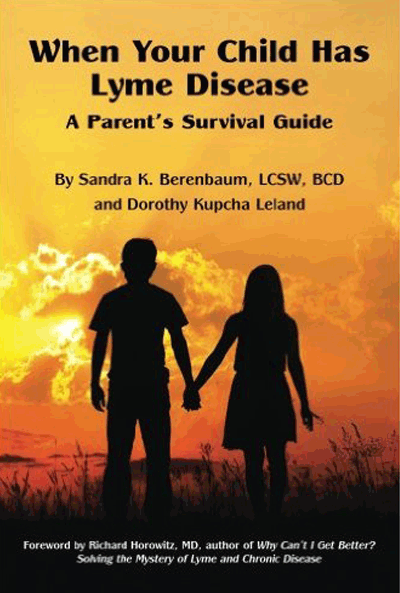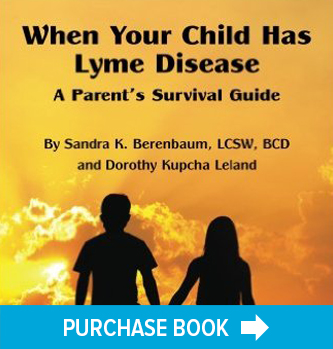When Your Child Has Lyme Disease – A Parent’s Survival Guide
Reviewed By: John McCormick, Huffington Post
When my son Will was first diagnosed with Lyme disease in 2009, my wife and I didn’t have a clue what Lyme was or what was in store for our family. For starters, we thought all Lyme cases could be cured with a short course of antibiotics. But when Will’s symptoms persisted after a three-week treatment, we were faced with an array of questions for which we had no answers.
• Why don’t the antibiotics work and what should we do next?
• How do we go about learning more about Lyme disease and its treatment?
• Is there such a thing as chronic Lyme?
• How do we find a specialist who knows how to treat chronic Lyme?
• How will this disease affect our son’s future?
Unsure where to turn, we spent hours combing through the often conflicting literature on the disease, looking for answers to these and other questions. We eventually found a specialist who started Will on a lengthy course of antibiotics, but I wish there had been a guide just for parents like us who were in need of advice and support.
Now, there is. If, like my wife and I, you have a child with Lyme disease, When Your Child Has Lyme Disease: A Parent’s Survival Guide may prove an invaluable resource. Written by two dedicated Lyme advocates, Sandra Berenbaum and Dorothy Kupcha Leland, this remarkable book is both a practical guide and emotional touchstone. Sandra Berenbaum brings her experience as a Connecticut psychotherapist who has counseled Lyme patients and their families for over 20 years, while co-author Dorothy Kupcha Leland provides a parent’s perspective.
In Leland’s case, in 2005 her then-13-year-old daughter became seriously disabled with what turned out to be Lyme disease. By the time the correct diagnosis was made, the disease had burrowed deep into her daughter’s body and became difficult to root out. But finding the proper diagnosis and treatment was only the first challenge.
“Equally hard was dealing with the emotional isolation a family can experience at such a time,” Leland writes. “We felt very alone. But, in fact, we were part of a growing yet invisible group — families grappling with a disease that is largely ignored by the medical establishment.”
Leland’s words resonate with me. We have all, as parents of children with Lyme, spent sleepless nights agonizing over whether we’re getting the proper medical care for our kids, or whether some doctors, and even our friends and family, are right when they raise doubts about our treatment decisions.
Worse, we suffer from the constant worry that our stricken children will miss out on their youth, which should be a time of joy and exploration, or that their lives will be so compromised they won’t reach their full potential.
Berenbaum and Leland’s approach to these difficult issues can be transforming. They refer to the experience that Lyme families go through as a journey, one marked by disappointment over occasional setbacks but also by joy over breakthroughs. Above all, it’s an experience characterized by learning, adapting, leaning on friends and family, and never — ever — giving up.
If you have a child with Lyme, no matter where you and your family are on this journey, this guide can help.
• If you’re just learning about Lyme disease, the book is filled with practical information. If you have questions about different kinds of lab testing or don’t understand what a co-infection is, this is your resource.
• If you’re a harried, financially-strapped, stressed-out parent, you’ll learn how to find a Lyme-literate doctor in your area, and understand the difficulties in obtaining medical expense reimbursements from your insurance company.
• If you don’t understand why Lyme disease is so controversial, the authors provide a helpful explanation as to why the medical community is deeply divided over the best approach for diagnosing and treating Lyme disease, and why the controversy affects the treatments available to your child.
• If you want to become a Lyme advocate, you’ll find a list of the leading education, advocacy, support, and fundraising organizations, and what the Lyme community needs to do to alleviate the toll the disease wreaks on individuals and society at large.
Finally, Berenbaum and Leland offer hope and reassurance to parents like me who constantly worry about their child once he or she has suffered from Lyme disease. In our case, our son was lucky. His doctors caught the disease before it had infected his nervous system, and thanks to the additional antibiotics, today Will leads the normal, healthy life of an active high school teenager.
Still, I hit the panic button whenever troublesome symptoms such as chills, aches or fatigue pop up. The authors understand this, and beyond their reliable, practical advice, offer healing and peace of mind.
As Berenbaum writes,
I urge you to greet every morning as a new day. Do what needs to be done,
and learn what needs to be learned. Don’t burden yourself with worry about
what is still to come. You and your family can get past the trials and
tribulations of this moment, fostering a resilience that will carry you through
to the future. My hope is that you will not only survive Lyme disease, but
triumph over it.
John McCormick and his sons William and Connor are the authors of the book, “Dad, Tell Me A Story,” How to Revive the Tradition of Storytelling with Your Children (Nicasio Press 2013). For more information about family storytelling and their book, visit the authors’ website and blog at http://DadTellMeAStory.com.
You can also follow the authors on Twitter or join them on Facebook.


















